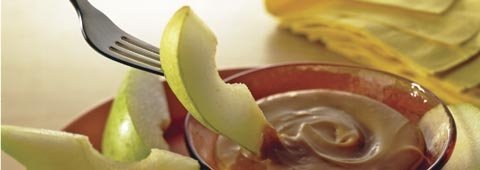
How crisp should a fresh-sliced pear be? Some people like pears soft, while others like them crunchy.
The equivalent of more than a million boxes of apples were sold in the form of fresh slices last year. Advancements in quality control and market ingenuity brought enough awareness that even McDonald’s added apple slices to its everyday menu.
Now that apples have reveled in fresh-cut glory, wouldn’t it be natural to capitalize on other similar fruits—say, pears?
“I personally think we’ve got to move it forward, because looking at the produce department, there’s so much value added, and the convenience factor is so important,” said Kevin Moffitt of the Pear Bureau Northwest in Milwaukie, Oregon.
Processors agree that fresh-cut pears hold promise, but they also present big challenges. Shipping, distribution, and consumer preference are just a few issues that need to be addressed before fresh-cut pears hit store shelves.
Challenges
“Pears are odd-shaped, they ripen differently, and they have different taste profiles,” said Ned Rawn, director for fresh slices at Tree Top, Inc., in Selah, Washington. The trick to winning over consumers, he continued, is to get consistent, good-tasting product 100 percent of the time.
“It’s not unlike the problem of bagging lettuce,” he commented. From tree to consumer, the internal quality must be topnotch, since the inside of the pears will be exposed for all to see.
Is technology ready for such a feat?
In the world of sliced fruit, technology is an ongoing process that is continually refined, Rawn said. The perfection of current technologies can be a springboard to the next product release. Whether there is other technology that will better suit the development of fresh-cut pears remains to be discovered.
Spoilage
Another issue is consistency. There seem to be some problems with the consistency of ripeness of pears in a box when they are preripened, Moffitt commented. There are nondestructive sensors that measure pressure. However, no one is making that jump—apples took up all their time and money.
“What the holdup is right now is the fact that pears need to be about seven pounds pressure or less before the consumers feel it is a tasty piece of fruit,” said Moffitt. And when pears are shipped at pressures below seven or eight pounds, the amount of spoilage is unacceptable. The pears turn mushy or they break.
“From a transportation standpoint, no one has figured out how to ship the fruit further than 100 miles or so,” continued Moffitt. A producer in Hood River could ship to Portland, but national distribution would be problematic. The slices would have to be packed in a rigid container, rather than a polybag.
Developers also have to figure out the optimal level of fresh-cut pear crispness. Some consumers may prefer crunchy, while others prefer a softer sliced pear.
“How do people want to eat them? If you ask five people, you’ll get five answers,” said Tony Freytag, director of Crunch Pak in Wenatchee, Washington. Crunch Pak has been researching sliced fruit for more than five years, pears being one of the first fruits it tested.
“We’ve conducted a number of consumer studies. We’re not convinced we know what the consumers want. Maybe it’ll be a cup of diced apples with diced pears. Or maybe it’ll be in the foodservice side.”
In addition, the size of the potential fresh-cut pear market is a challenge. Freytag says it is only 2 percent the size of the sliced apple market. Investments in fresh-cut pear processing facilities can be pricey. With that and other factors in place, what is the pricing point? What will consumers pay for fresh-cut pears? Could they be priced the same as fresh-cut apples? Though all these challenges lie ahead, it doesn’t mean bringing fresh-cut pears to the marketplace wouldn’t be worth the trouble.
“Never say never,” Freytag said. “A lot of people said it would never happen with apples.”
Crunch Pak knows the growth of sliced apples all too well. A year ago, when its sliced apple plant opened, it operated on a five-day work week with one shift. Now it’s up to six days with two shifts.
“We’ve had our hands full,” he said.
More research
Experts agree that a lot of research still needs to be conducted in order to pick a perfect pack of presliced pears. Moffitt is already on top of it. The Pear Bureau applied for a rural development matching grant to explore the idea of fresh-cut pears with current or potential processors and identify the pitfalls and opportunities.
“I’m not sure the whole industry is going to go to cut pears, but I think we need to start considering a percentage of the crop in this form,” Moffitt continued.
In general, processors seem excited about the possibility of fresh-cut pears, and they hope it’s something that will be worthwhile to growers.
“It’s fun to be on the front edge of forward thinking,” Rawn said.
Carrie Snider is an agricultural freelance writer based in Yakima, Washington. She grew up on a dairy farm in eastern Oregon.

Leave A Comment